Belinda Baggs, Kimi Werner, and Jarrah and Wayne Lynch set out on a grand expedition to explore Australia’s Great Barrier Reef. They spent two weeks sailing and diving the reef, observing the condition of one of the world’s most spectacular natural wonders.
Watch their short film and get a more in-depth story from Wayne below.
You know, it’s strange, you grow up as a kid in Australia and you see all these photos of the Great Barrier Reef and you hear all about it, and you feel you have some understanding or knowledge about the reef, but until you actually go up there and see it firsthand you can’t ever truly appreciate it—just how enormous it is, the scope and complexity of it, and the vibrancy of sea life out there. Even for someone like me who has spent much of their life in the ocean, it took me completely by surprise. It was one of those experiences I’ll personally never forget, and you don’t get a whole lot of those in your life. It was a seminal moment for me in the way that I see my own country.
The Great Barrier Reef is around 2,500 miles long, the largest living thing on earth. I’ve sailed right past it while sailing out into the Pacific, but I’ve never actually stopped there, and spent time on it. I’m kicking myself now.
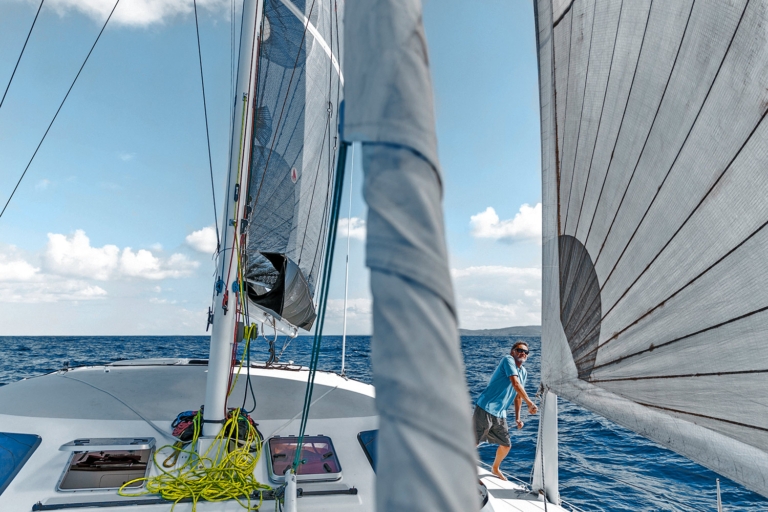
“Until you go up there and see the Great Barrier Reef firsthand,” writes Wayne Lynch, “you can’t ever truly appreciate it—just how enormous it is, the scope and complexity of it, and the vibrancy of the sea life out there.” Photo: Jarrah Lynch
We spent two weeks sailing and diving on the reef last August, observing the reef’s condition. The marine life took me aback. It was almost too much at times. It’s like diving into a botanical garden and you’re just floating along experiencing a total sensory overload. With the reef and the coral, there’s such diversity, so much shape and form and colour. The complexity and interconnectedness of the marine life out there dawned on me the more I saw of it. The reef started to make more sense. There are certain fish that grab your attention. I love the clownfish with the character and colour that just evoked affection for them. But there’s everything there from whales to sharks and manta rays to dolphins, all the big things, but it runs all the way down to the tiniest fish and animals.
We explored some of the islands out there and they were stunning. All those Whitsunday Islands feel like you’re somewhere else. They’re so lush it doesn’t feel like Australia. From a sailing perspective, it’s fantastic, especially out on the reef itself because you get this beautiful, relatively flat ocean with this clean wind with no turbulence in it. It’s like sailing on silk.
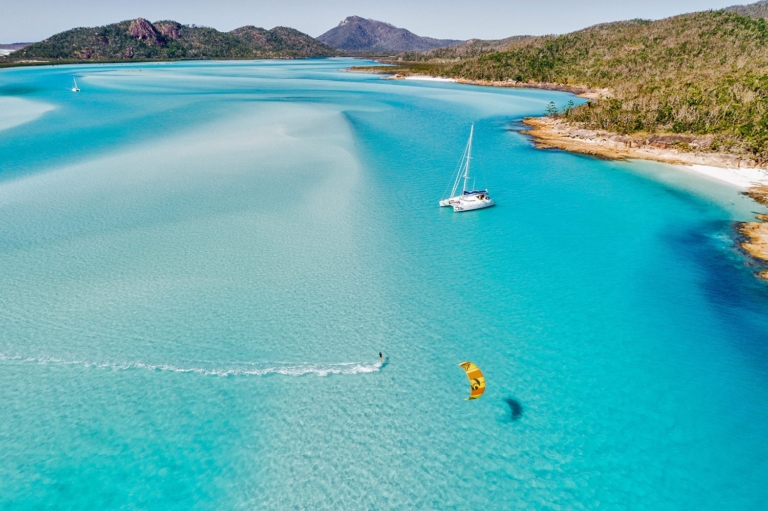
Emma Sant kites over the silica sands of Whitsunday Island, just west of the Great Barrier Reef. Photo: Jarrah Lynch
Ask Australia’s Prime Minister, Malcolm Turnbull, to protect our Great Barrier Reef and stop Adani’s giant coal mine!
Over those two weeks and hundreds of miles sailing, however, it became obvious that the reef was in varying states of health and degradation. We dived in areas that were completely dead, nothing but white rubble devoid of any fish life at all. That was quite a shock and depressing. Moving further north, however, we did find some pristine areas, teeming with magnificent and complex reef structure and a vast sea life presence.
There was no doubt in my mind that the reef is indeed under serious threat from global warming, sediment runoff and powerful cyclonic storms fueled by climate change. Since my return, I’ve read extensively. I wanted to know the facts of the scientific studies being made regarding the reef’s status and future.
In one way it was an incredibly inspiring trip, on the other side, it was a real concern, just the lack of understanding in our country about what is going on up there. All these decisions about the reef are being made far away by people who’ve never seen the reef in that way. No words can ever translate the experience of seeing it firsthand, so all I could do in my little way was trying to bring to people’s attention what we stand to lose.
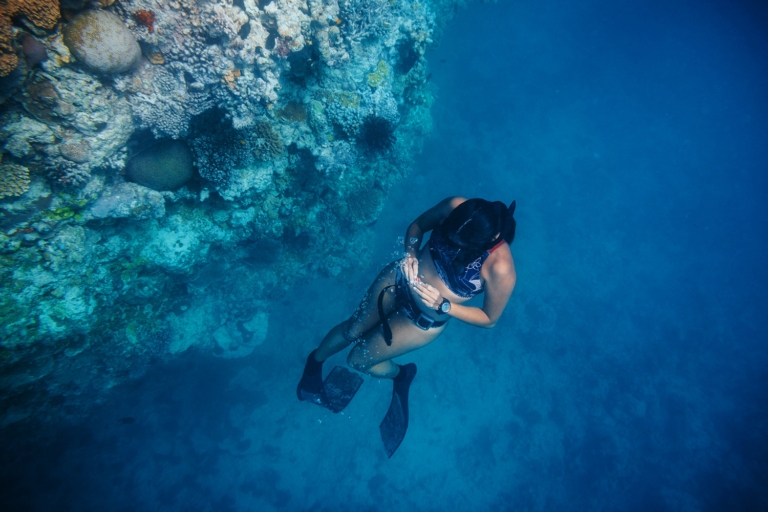
Freediver Kimi Werner examines the small-scale health of the world’s largest living structure. The impacts of climate change are putting the reef’s survival in doubt—and, increasingly, galvanizing opposition to the proposed Carmichael coal mine. Photo: Jarrah Lynch
The outlook I believe is not good, given the attitudes and trends both in climate change and the political attitudes prevailing both in Queensland and with the federal government here in Australia. It seems to me that it would be an act of total irresponsibility and moral corruption to allow the reef to die through inaction, whether that is from disinterest, political incompetency or the greed of self-interest.
How can we let it be threatened by something as dangerous as the Carmichael coal mine? Proposed by giant Indian resource company Adani and located adjacent to the reef on the Galilee Basin in central Queensland, it will be the largest coal mine in Australia, and one of the largest in the world. It is the first in several coal mines proposed for the area that would cover a surface area five times bigger than Sydney Harbor. All of that coal would be shipped out from the Point Abbott terminal straight through the Great Barrier Reef, all of it destined to be burned.
The benefits of the Carmichael mine to the country are negligible. Adani has exaggerated the number of potential jobs the mine will create. At most the figure is around 1,500 jobs if the mine reaches full capacity over 60 years. Meanwhile, much of the revenue generated by this mine will be leaving the country and going into overseas tax havens. Adani has also been under serious criminal investigation in its home country of India for corruption and breaches of environmental guidelines. Countering this, tourism on the reef currently generates six billion dollars annually and employs around 70,000 people. For the sake of what I feel is political expediency, it’s not necessary to mine up there. There are other ways to create jobs in Queensland.
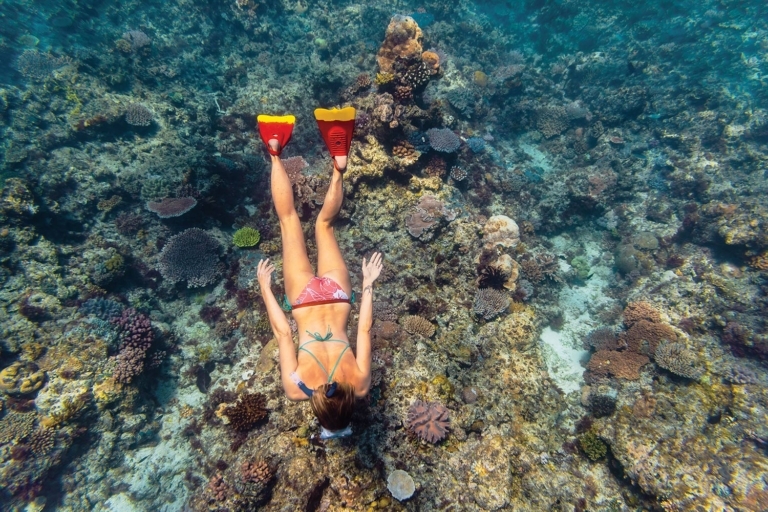
Belinda Baggs takes the close-up view with mask, snorkel and fins. The reef’s astonishing biodiversity is being swiftly degraded, with severe coral bleaching caused by heat stress impacting large areas of the reef in 2016 and 2017. Photo: Jarrah Lynch
Just as important to me, they’re going to take the land for the mine from the Aboriginal people, the Wangan & Jagalingou, to make this happen. This is 2018 and we’re still functioning with a colonial mindset. That land is theirs, it’s been given back to them through Australian law, and they’re going to have it taken away from them and turned into a giant hole in the ground? To me, this feels like theft. At every level, this is just wrong, and I don’t see how we can hope to have a just society when we continue to do that to the Aboriginal people.
Farmers, scientists and the traditional owners agree this mine will be a social and environmental catastrophe if allowed to proceed. Australians need to be told the truth. For me this is not just about politics and a battle of ideologies, it’s far more profound. When they stopped the damming of the Franklin River in Tasmania in the 1980s that was seen as a huge win, but in time we’ve come to realize what a huge win it was. People now look back and count their lucky stars that the dam was stopped and the river runs wild today. It was a huge environmental win, but it was something more than that. That river also survived spiritually in the people who stood up and helped save it. Saving the Franklin River created a belief that other natural treasures could also be saved.
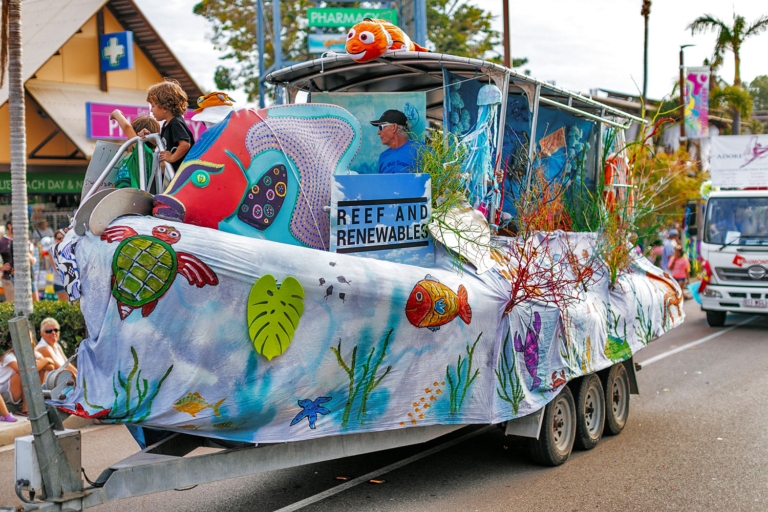
Led by local activists, work to protect the Great Barrier Reef is rolling along and gathering pace. Airlie Beach, Australia. Photo: Jarrah Lynch
The Great Barrier Reef might be even more important. The Franklin victory fell on the right side of history, and we don’t want to be the generation who could have saved the reef, but didn’t.
I would urge anyone reading this to investigate the facts for themselves. You can do this online with the Australian Marine Conservation Society, Enviro Justice Australia and by watching the objective and a thoroughly researched episode of Four Corners entitled “Digging Into Adani.”
This article was originally written for Patagonia.com by Wayne Lynch
[WATCH: “The Reef Beneath:” A Film About Exploring the Great Barrier Reef]


